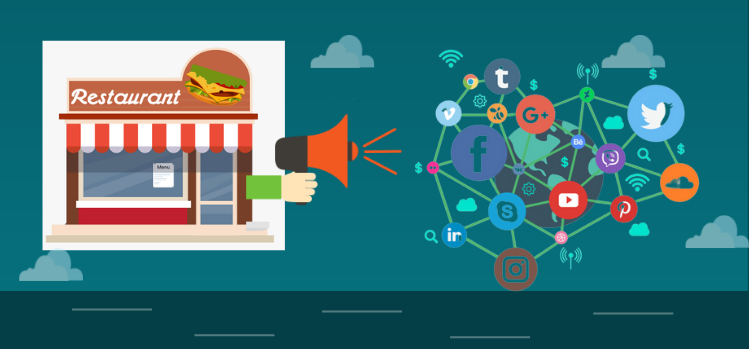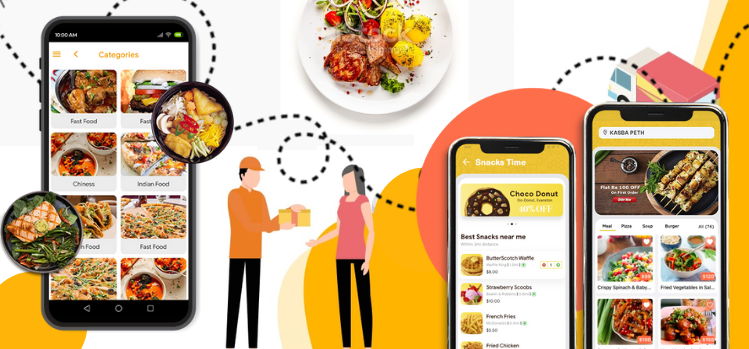How to Market a Restaurant? Effective Restaurant Marketing Ideas.
India has 53,000 hotels and 70 lakh restaurants in the organized category and a lot more in the unorganized category. The National Restaurant Association of India pegs the Indian restaurant industry to be worth a whopping Rs 43,000 crore. It predicts the growth rate to be around 5-6% per annum. On average, a big city like Delhi sees ten new restaurants crop up every single day.
However, a lesser-known fact is that among all businesses, it is the restaurant business that has the worst casualty rate.
- 1 out of 3 restaurants shuts shop in the first 3 months of operations.
- 2 out of 3 restaurants shut shop within 1 year of operations.
These numbers are shocking considering the sheer investment in terms of both time and money that starting a new restaurant business demands.
So why doesn’t the restaurant business succeed? What is the secret of running a successful restaurant? What X factor do the failing restaurants lack?
Introduction -
Like any business, many aspects go into running a successful restaurant. Some of these are in your control, others aren’t. Gone are the days when the location was considered paramount to a restaurant’s success. The adamant of technology and the internet has brought the restaurant into the consumer’s hands. This has to some extent eliminated the need for a restaurant to be in a prime location to be identified. Then, there is the quality of food – which again depends on various uncontrollable aspects. The sourcing of the ingredients, the seasonality, the cost, and most importantly the chef. Restaurants that can maintain quality consistently for a longer period, are the ones that tend to succeed.
Did you know –
A new restaurant typically spends more than 15%-20% of its revenue on marketing
Finally, there is the marketing strategy. An aspect that is much ignored and less talked about in the industry. Something that is completely in your control. An function if done right can be the cornerstone of a successful restaurant business. According to me, it is the consumer that makes or breaks a business. Even if your restaurant has the best location, best food, best staff, best ambiance, and best offers and discounts. If you are not doing marketing right, then you will not be able to attract the consumers and without a consumer, a restaurant is nothing but a well-decorated kitchen.
With that in mind, In the next few paragraphs. I am going to detail some highly effective ways of marketing a restaurant
Brand Building – Identity and USP
The first question you need to ask yourself is why should a consumer eat food from your restaurant when he/she has so many options? What is so unique about your restaurant? It might be anything. The ambiance, the staff, and a special item on the menu that is different from any other restaurant. It could also be the size of the portions you serve, your presentation of food, etc.
- Bukhara (New Delhi) – Best tandoori dishes, Dominos (across India)– Fastest delivery time, Vaishali (Pune)– Best south-Indian food and Barbeque Nation - Buffets
When you find out what makes your restaurant different from the rest. That one aspect becomes your USP (unique selling proposition) and your entire marketing strategy can then be based around that.
If “relaxed ambiance” is your USP, then the idea is that every marketing communication or promotion that you plan to put out should have “relaxed ambiance” as a constant theme. This will ensure that when consumers visit your restaurant, they will be expecting a relaxed ambiance. When they experience the same, they are delighted. The cycle continues till eventually, your target audience should equate your restaurant name with the feeling of a relaxed atmosphere.
Building a Presence – Online & Offline
The next step after brand identification is building and establishing your presence. Before you start an advertising or promotion campaign, it is imperative to ensure that your restaurant is present both online and offline.
Establishing an offline presence is straightforward. Apart from the physical presence of the restaurant, putting up hoardings, distributing flyers, and cultivating local tie-ups can achieve that goal.
Online marketing however is tricky. Depending upon the budget, the USP, and target audience, one can explore various spheres of an online presence
Did you know –
81% of consumers' choice of restaurant is strongly influenced by social media posts and online reviews
As a bare minimum, you will need to create a website. Nothing fancy, Just a homepage that has your restaurant name, the location, and some photographs.
A menu page – that details the menu items. An about us – that talks about the restaurant, its USP, its branches, and its owners. Finally the most important of all is a review page. This is where users can go and talk about their experiences in your restaurant. Interacting and engaging with your customers is the key here as customers are more likely to return to your restaurant if they feel wanted. The way the website is designed especially the menu also makes a huge impact on how your restaurant is perceived. As discussed in the earlier point – your USP messaging needs to constantly and consistently appear on your website.
You can also add blogs, a recipe page, a contact page, book a table, a food ordering page, etc.
The other aspect of online presence is social media and food delivery apps which I will discuss in detail in the subsequent points.
Social Media -
Next on the list is to get your social profile up and running. The impact of social media platforms in our lives has been undeniable. It is a place where identity and narratives are formed. Any person/page/brand that has a substantial following can persuade and influence a large group of people.
Your restaurant’s presence on these sites is paramount if you are serious about building trust and long-term relationships with your customers. The most popular among them are Facebook and Instagram. However, platforms like Twitter, YouTube, and even LinkedIn are becoming more and more influential
You can start by creating a page (Facebook) or creating an account (Instagram) for your restaurant. Fill the profile section with as much detail as possible, starting with the right address, phone number, website URL, etc. Pictures and videos of your restaurant will give you that added advantage since audio-visual content is much easier to consume. The most basic function of your social media presence is to create awareness about your brand.
However, you can use this medium to a much greater effect, if you are willing to put in the effort. Engaging on social media will allow you to talk to consumers and give them something beyond the restaurant experience. By commenting on posts, sharing photos of food and staff, and putting out exclusive offers. You create a community that expands far beyond your physical location.
Encourage every consumer who has had a pleasant experience visiting your restaurant or ordering food to follow you or Like your page on these various social media platforms. You can incentivize them by offering discounts or vouchers on their next visit.
Did you know –
That 60% of the consumers that order Food Delivery through apps are millennials.
This will start you off, eventually gaining more and more followers/likes as you go. Once you reach a substantial number, your social media communication will start driving real value. You can use it to promote an event or announce a special menu item that you wish to introduce. You can also use it to garner feedback and comments from consumers. While highlighting positive reviews will attract more consumers to your restaurant. It is also important how to manage negative reviews.
Review handling is perhaps the most critical aspect of social media marketing and needs to be done right. Both the quantity and quality of reviews impact how high you rank across all search results. The content of those reviews can also make for excellent marketing material. Communication is key, many restaurants even hire professionals – photographers and content writers to run their social media platforms.
Food Delivery Apps -
As mentioned above, the advent of technology has changed consumer behavior forever. While dining out is still an experience that consumers look forward to, it is “food delivery” that is easily the most preferred option by consumers today.
The reason is simple – with their busy lifestyles, and 10 to 12-hour-long working hours. Most people fail to plan their meals and end up choosing to order food. With 10 min delivery becoming a new norm the customer is already spoilt.
The other reason is choice – when a customer opens a Zomato or a Swiggy app he/she is presented with a variety of options. This is where a customer can try out a new restaurant. Without the hassle of having to physically visit the restaurant.
However, the most important reason why your restaurant should be marketed in food delivery apps is that over 80% of all mobile phone users have either 1 or 2 food delivery apps installed. That is an enormous number of potential consumers that can be targeted.
Having your restaurant feature in food delivery apps is beneficial both strategically as well as financially. Many restaurants during the pandemic survived only based on their presence in such apps.
It is advised to enlist your restaurant into all of the major Food delivery apps eg – Zomato, Swiggy, Amazon, etc. The procedure is identical for all of them and requires minimal paperwork. While this seems pretty easy, there are some areas that you need to keep in mind.
- Keep an easy-to-surf menu - While your restaurant might have an elaborate menu. It is advised to keep your food delivery app menu concise, with your best-selling items right at the top. If a new consumer wants to try out your restaurant through the food delivery app, it is best to offer them your best dish.
- Keep an easy-to-surf menu - While your restaurant might have an elaborate menu. It is advised to keep your food delivery app menu concise, with your best-selling items right at the top. If a new consumer wants to try out your restaurant through the food delivery app, it is best to offer them your best dish.
- Keep an easy-to-surf menu - While your restaurant might have an elaborate menu. It is advised to keep your food delivery app menu concise, with your best-selling items right at the top. If a new consumer wants to try out your restaurant through the food delivery app, it is best to offer them your best dish.
Own Delivery Apps -
While aggregate food delivery apps such as Zomato and Swiggy are great to provide your restaurant with the much-required reach, their hefty commissions and inflexibility are factors that one can’t ignore. It is for that reason that more and more restaurants are adopting a D2C model. They are creating their delivery app.
With technology becoming more and more user-friendly building your restaurant app is easier than ever. By creating your delivery app, you have full control over the customer experience. Right from ordering to delivery and feedback. Since you will eliminate these 3rd party apps. Your margins are better and you can even offer consumers a higher discount or even a better deal. Having a direct ordering app means you can easily track and fulfill orders. Since the app will integrate seamlessly with your existing POS saving you time and hassle.
However, the most important reason why a restaurant should have its delivery app is because of access to consumer data. In today’s day and age, Information is an invaluable resource. Having your app provides you with unlimited access to customer data. This can be analyzed to study patterns, trends, and overall behavior. In short, such data can help you understand the customer need in more detail, which in turn can help you design not only a more effective marketing strategy but also an efficient supply chain management system. The opportunities are infinite.
Google Maps -
This one is a no-brainer – Set up your Google Business profile and add your restaurant’s address to Google Maps along with timings and contact information to show people in your area that you are open for business during these hours.
This is a lot more important than it seems. A Google listing allows your restaurant to appear in local search results, along with directions on how to get there from wherever the consumer is searching. Adding your business to Google maps is super easy- all you need to do is mark your location with your restaurant name in Google Maps. Google maps will ask you to do a simple verification, and you are in.
Did you know –
A mere 10% rise in customer retention can lead to a 75% increase in restaurant profitability
Google also throws in a right-side Knowledge Panel with all the details of your restaurant when someone does even a regular search. This is free marketing and highly effective.
Food lovers are often known to do research online – in fact, 79% of consumers research a restaurant online before dining. Hence the more detailed and more accurate your online details are, the better.
Keep this page updated with menus, pictures, and all the latest developments.
Loyalty Program -
This might be one of the age-old marketing techniques, but it is still very effective. A carefully designed loyalty reward program goes a long way in not only retaining existing consumers but also acquiring new ones.
According to a recent study, loyal customers constitute about 53-76% of a restaurant’s business. Hence one should build and maintain a relationship with customers who visit your restaurant regularly. There is more to loyalty programs than just discounts and freebies.
Here are a few examples of how this can be done –
- Offering discounts or complimentary giveaways
- A premium membership level in the restaurant app.
- Delivering personalized service eg – a relationship manager
- Priority services such as reservations during weekends
- Providing a special menu or “off the menu” items.
- Offering premium and exclusive merchandise
The key is to make the consumers feel valued and respected. Word of mouth is the strongest form of marketing. And a sure shot way of getting that is through your loyal consumers by just keeping them happy. You can encourage your loyal consumers to write a blog about /her experience or to mention your restaurant in popular food blogs or food-related pages. Sometimes such mentions and tags travel and reach places regular marketing cannot.
Healthy Menu -
With the recent pandemic, there is a conscious and considerable movement towards a healthy lifestyle. More and more consumers are looking for healthier food options. Vegan and Gluten-Free diets are fast becoming routine choices for many consumers. While in the west the restaurant industry has understood this. The Indian restaurant industry has been rather slow to react.
Providing an alternative option, a “healthy menu” can be one of the quickest ways to attract new consumers. By just using healthy ingredients and cooking with less oil you can create a healthy alternative menu that your consumers can enjoy guilt-free. Since its healthy, it is more likely that consumers will visit/order more frequently, which in turn increases the revenue. This is also a huge opportunity to differentiate your restaurant from the others in a more meaningful way.
Many new brands like Eat. fit and Grow. fit is only focusing solely on Healthy food.
Did you know –
India is the 3rd most obese country in the world, only behind US and China
Conclusion -
There is no right or wrong way to market a restaurant business. The idea is to get your brand identity in place and do the basics right. Once you are done with those, then keep experimenting based on the latest trends, Innovations, and interests. Communication and engagement will act like oxygen, keeping your restaurant brand relevant. A great piece of advice would be to hire someone with digital marketing experience to manage the online marketing aspect. You could also outsource it to an agency to do the same.
Here is hoping you found these tips useful and are looking forward to putting in into practice.







Add comment